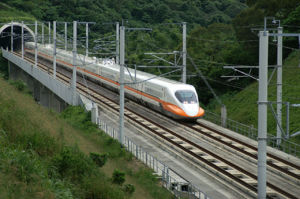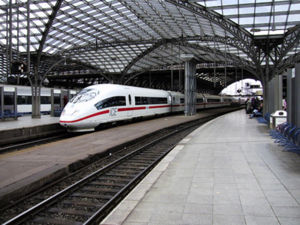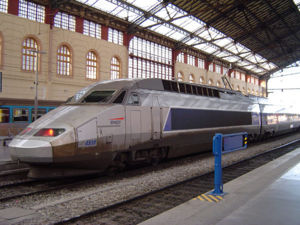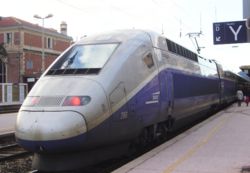High-speed rail
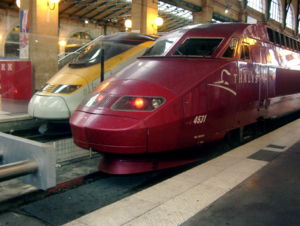
High-speed rail is public transport by rail at speeds in excess of 200 km/h (125 mph). According to UIC, "high-speed train" is a train that runs at over 250 km/h on dedicated tracks, or over 200 km/h on upgraded conventional tracks.[1]
Typically, high-speed trains travel at top service speeds of between 250 km/h and 300 km/h (155 mph and 186 mph). The world speed record for a conventional wheeled train was set by a French TGV that reached a speed of 553 km/h (343 mph) in 2007[2] (breaking its own record of 515.3 km/h (320.2 mph) set in 1990). A Japanese magnetic levitation train (maglev) JR-Maglev MLX01 in development has reached 581 km/h (361 mph). Currently, however, the only magnetic levitation train in commercial service is operating in Shanghai, China. In the coming years more Maglev trains are planned in the country.
Contents
Definition
The International Union of Railways' high-speed task force provides definitions of high-speed rail travel [2]. There is no single definition of the term, but rather a combination of elements—new or upgraded track, rolling stock, operating practices—that lead to high-speed rail operations. The speeds at which a train must travel to qualify as 'high-speed' vary from country to country, ranging from 160 km/h (100 mph) to over 300 km/h (186 mph). The countries that have high-speed rail in operation are: Belgium, China, France, Germany, Italy, Japan, Portugal, South Korea, Spain, Taiwan, the United Kingdom, and the United States. For details of current systems, see High-speed rail by country.
History
Railways were the first form of mass transportation, and until the development of the motorcar in the early 20th century had an effective monopoly on land transport. Railway companies in Europe and the United States used streamlined trains since 1933 for high speed services with an average speed of up to 130 km/h and top speed of more than 160 km/h. With this service they were able to compete with the upcoming airplanes. World War II stopped these services.
In the decades after World War II, cheap oil, coupled with improvements in automobiles, highways, and aircraft made those means practical for a greater portion of the population than previously. In Europe and Japan, emphasis was given to rebuilding the railways after the war. In the United States, emphasis was given to building a huge national interstate highway system and airports. Urban mass transport systems in the United States were largely neglected. The U.S. railways have been less competitive partly because the government has tended to favour road and air transportation more than in Japan and European countries, and partly because of lower population density in the United States. Travel by rail becomes more competitive in areas of higher population density or where gasoline is expensive, because conventional trains are more fuel efficient than cars (though sometimes less fuel efficient than buses). Very few high-speed trains consume diesel or other fossil fuels but the power stations that provide electric trains with power do consume fuel, usually natural gas or coal. However, in Japan and France, a large proportion of the electricity comes from nuclear power. Even using electricity generated from coal or oil, trains are more fuel efficient per passenger per kilometer travelled than the typical automobile. Upgrading rail networks require large fixed investments and thus require unsubsidizing fuel costs, or high population densities to be competitive against airplanes and automobiles. Population density has always been a key factor in the success of European and Japanese railway transport, especially in countries such as the Netherlands, Belgium, Germany and Switzerland.
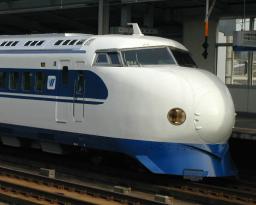
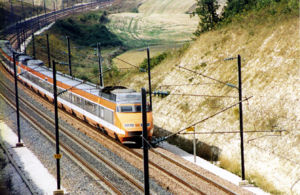
The world's first "high-speed train" was Japan's Tōkaidō Shinkansen, officially launched in October 1964, construction began in 1959. The "Series 0" Shinkansen, built by Kawasaki Heavy Industries, achieved speeds of 200 km/h (125 mph) on the Tokyo–Nagoya–Kyoto–Osaka route.
High-speed rail was conceived as an attempt to win back railway passengers who had been lost to other means of travel; in most cases it has been quite successful at accomplishing this goal.
Comparison with other modes of transport
High speed rail is often viewed as an isolated system and simply as advantageous or disadvantageous as compared to other transport systems, but all transport systems must work together to maximise benefits. A good HSR system has capacity for non-stop and local services, and has good connectivity with other transport systems.
Due to current infrastructure designs in many nations, there are constraints on the growth of the highway and air travel systems. Some key factors promoting HSR is that airports and highways have no room to expand, and are often overloaded. High-speed rail has the potential for high capacity on its fixed corridors, and has the potential to relieve congestion on the other systems. High speed trains in themselves are more environmentally friendly than air or road travel. This is due to:
- lower energy consumption per passenger kilometre
- reduced land usage for a given capacity compared to motorways
- displaced usage from more environmentally damaging modes of transport.
Automobiles
High-speed rail has the advantage over automobiles in that it can move passengers at speeds far faster than those possible by car. The lower limit for HSR (200 km/hr, 125mph) is substantially faster than the highest road speed limit in any country. Ignoring countries without a general speed limit (like the German autobahns), the highest speed limit is 160 km/h (100 mph), experimentally posted on selected test stretches in Austria and the United Arab Emirates [3], while 120km/hr or 75mph is more typical. Very few public roads have no speed limit. For journeys that connect city centre to city centre, HSR's advantage is increased due to the slower speed limits within most urban areas. The longer the journey, the better the time advantage of rail over road.
Moreover, train tracks permit a far higher throughput of passengers per hour than a road the same width. A high speed rail needs just a double track railway, one track for each direction. A typical capacity is 15 trains per hour and 800 passengers per train (as for the Eurostar sets), which implies a capacity of 12,000 passengers per hour in each direction. By way of contrast, the Highway Capacity Manual gives a maximum capacity for a single lane of highway of 2,250 passenger cars per hour (without any trucks or RVs). Assuming an average vehicle occupancy of 1.57 people [4], a standard twin track railway has a capacity 3.3 times greater than an 6-lane highway (3 lanes each way), while requiring less than half the land (1.0/3.0 versus 2.5/7.5 hectares per kilometer of direct/indirect land consumption).
Journeys by train have much lower environmental costs in addition to being less stressful, more productive and more reliable than car journeys. Additonally, the link between efficient and competitive public transport (such as high-speed rail) and sustainable urban planning has been noted by numerous studies over the past 50 years.
Aeroplanes
While high-speed trains generally do not travel as fast as jet aircraft, they have advantages over air travel for relatively short distances. When travelling less than about 650 km (400 mi), the process of checking in and going through security screening at airports, as well as the journey to the airport itself makes the total journey time comparable to HSR. Trains can be boarded more quickly in a central location, eliminating the speed advantage of air travel. As a rule of thumb, rail journeys need to be three hours or less to be competitive with air travel on journey time. In terms of distance, such journeys can theoretically span up to 900 kilometres (assuming travel at 300 km/h with no stops en-route).
Rail lines also permit far greater capacity and frequency of service than what is possible with aircraft, and rail schedules find fewer weather-related interruptions than do airline schedules. Another advantage of high speed rail over aircraft is comfort: the journey involves fewer modal changes, less standing and queuing, no air pressurisation issues, and generally more spacious seating. From the operator's point of view, a single train can call in at multiple stops, often far more stops than aircraft. One train stopping pattern can allow a multitude of possible journeys, increasing the potential market.
High speed trains are far more environmentally efficient than aircraft, as trains consume less energy per passenger kilometre. This results in less carbon dioxide emissions, thus reducing the greenhouse effect answerable for the global warming. This advantage is particularly strong with short-haul flights (where rail competes best on time). From the point of view of required traffic control systems and infrastructure, high-speed rail has the added advantage of being much simpler to control due to its predictable course, even at very high passenger loads; this issue is becoming more relevant as air traffic reaches its safe limit in busy airspaces over London, New York, and other large centres.
Target areas for high-speed trains
- Main articles: High-speed rail by country and Planned high-speed rail by country
The early target areas, identified by France, Japan, and the U.S., were connections between pairs of large cities. In France this was Paris–Lyon, in Japan Tokyo–Osaka, and in the U.S. the proposals are in high-density areas. The only high-speed rail service at present in the U.S. is the Acela Express, in the Northeast Corridor between Boston, New York and Washington, D.C.; it uses tilting trains to achieve high speeds (though much lower than those of their European and Asian counterparts) on existing tracks, since building new, straighter lines was not practical given the amount of development on either side of the right of way.
One notable fact is that in Europe, Korea, and Japan, dense networks of city subways and railways connect seamlessly with high speed rail lines. Despite efforts to create high speed rail in the USA, cities that lack dense intra-city rail infrastructure will find low ridership for high speed rail, as it is incompatible with existing automobile infrastructure. (People will want to drive when travelling in city, so they might as well drive the entire trip). Since in Japan intra-city rail daily usage per capita is the highest, it follows naturally that ridership of 6 billion passengers [3] exceeds the TGV of 1 billion (until 2003), the only other system to reach a billion cumulative passengers. [4] Some systems such as Korea's KTX have been plagued by low ridership, despite having extensive subway systems in Seoul.
The California High Speed Rail Authority is currently studying a San Francisco Bay Area and Sacramento to Los Angeles and San Diego line. The Texas High Speed Rail and Transportation Corporation strives to bring Texas an innovative high-speed rail and multimodal transportation corridor. The Corporation developed the Brazos Express Corridor to link Central Texas.
Later high speed rail lines, such as the LGV Atlantique, the LGV Est, and most high speed lines in Germany, were designed as feeder routes branching into conventional rail lines, serving a larger number of medium-sized cities.
A side effect of the first high-speed rail lines in France was the opening up of previously isolated regions to fast economic development. Some newer high-speed lines have been planned primarily for this purpose, such as the Madrid–Sevilla line and the proposed Amsterdam–Groningen line.
Five years after construction began on the line, the first Japanese high-speed rail line opened on the eve of the 1964 Olympics in Tokyo, connecting the capital with Osaka. The first French high-speed rail line, or Ligne à grande vitesse (LGV), was opened in 1981 by SNCF, the French rail agency, planning starting in 1966 and construction in 1976.
Market segmentation has principally focused on the business travel market. The French focus on business travelers is reflected in the nature of their rail cars (including the all-important bar-car). Pleasure travel is a secondary market, though many of the French extensions connect with vacation beaches on the Atlantic and Mediterranean, as well as major amusement parks. Friday evenings are the peak time for TGVs (train à grande vitesse) (Metzler, 1992). The system has lowered prices on long distance travel to compete more effectively with air services, and as a result some cities within an hour of Paris by TGV have become commuter communities, thus increasing the market while restructuring land use.
Technology
Much of the technology behind high-speed rail is an improved application of existing technology (of the 1950's). By building a new rail infrastructure with 20th century engineering, including elimination of constrictions such as roadway at-grade (level) crossings, frequent stops, a succession of curves and reverse curves, and not sharing the right-of-way with freight or slower passenger trains, higher speeds (250–300 km/h) are maintained. Recent advances in wheeled trains in the last few decades have pushed even these limits past 400 km/h, among the advances being tilting trainsets and airbrakes. The record speed for a wheeled electric train is 515 km/h is held by a shortened TGV train and long straight track (see also Land speed record for railed vehicles). The French TGV routes typically combine some sections of older track, on which they run at standard speeds, with segments on new track to provide an overall high-speed, one-seat journey to many destinations, but sacrificing overall time.
In France, the cost of construction is minimised by adopting steeper grades rather than building tunnels and viaducts. Because the lines are dedicated to passengers, gradients of 3.5%, rather than the previous maximum of 1–1.5% for mixed traffic, are used. Possibly more expensive land is acquired in order to build straighter lines which minimize line construction as well as operating and maintenance costs. In other countries high-speed rail was built without those economies so that the railway can also support other traffic, such as freight. Experience has shown however, that trains of significantly different speeds cause massive decreases of line capacity. As a result, mixed-traffic lines are usually reserved for high-speed passenger trains during the daytime, while freight trains go at night. In some cases, nighttime high-speed trains are even diverted to lower speed lines in favor of freight traffic.
In mountainous Japan, most of the costs of high speed rail extension involve blasting long tunnels through mountains, not core technology or right of way itself.
Notes and references
- ↑ General definitions of highspeed. uic.asso.fr/ November 28, 2006. Retrieved on January 3, 2007.
- ↑ French high-speed TGV breaks world conventional rail-speed record. EarthTimes.org (2007-02-14). Retrieved on 2007-02-14.
- ↑ [1]
- ↑ US Department of Energy - Energy Efficiency and Renewable Energy : "Fact #257: March 3, 2003 - Vehicle Occupancy by Type of Vehicle"
See also
- Aérotrain
- Ground effect train
- Land speed record for railed vehicles
- Magnetic levitation train
- Megaproject
Further reading
- Hood, Christopher P. (2006). Shinkansen – From Bullet Train to Symbol of Modern Japan. Routledge. ISBN 0-415-32052-6.
External links
- Transrapid – Maglev: High-Speed in Asia (China, Shanghai), Japan (Yamanashi) and Germany (Munich; TVE)
- High Speed Maglev, International
- California High-Speed Rail Authority
- Treno alta velocità (TAV)
- High Speed Maglev Forum
|
High-speed trains: Acela Express • Advanced Passenger Train • AVE • China Railway High-speed • Eurostar • InterCity 225 • InterCityExpress • JR-Maglev MLX01 • HST • HSR-350x • Korea Train Express • Magnetic levitation trains • Pendolino • Shinkansen • TGV • Thalys • Transrapid • Treno Alta Velocità • X2000 | ||
| High-speed lines: Beijing-Tianjin • CTRL (London-Channel Tunnel) • Cologne-Aachen • Cologne-Frankfurt French LGV lines • Hanover-Würzburg • Northeast Corridor (Boston-Washington DC) • Nuremberg-Ingolstadt • HSL 1 (Brussels-Paris) HSL 2 (Leuven-Ans) • HSL 3 (Liège-Aachen) • HSL 4 (Brussels-Netherlands) • HSL-Zuid (Netherlands) Japanese Shinkansen lines | ||
|
By country: Belgium •
Canada • China • France • Germany • Italy • Japan • Korea (South) • Norway • Portugal • Spain | ||
zh-min-nan:Ko-sok-thih-lō· da:Højhastighedstog de:Hochgeschwindigkeitszug es:Línea de alta velocidad fr:Ligne à grande vitesse ko:고속철도 id:Kereta kecepatan tinggi it:Treno ad Alta Velocità he:רכבות מהירות nl:Hogesnelheidslijn ja:高速鉄道 pt:Comboios de Alta Velocidade ro:Trenuri de mare viteză sl:Hitra železnica fi:Suurnopeusjuna sv:Höghastighetståg tr:Hızlı tren zh:高速鐵路
